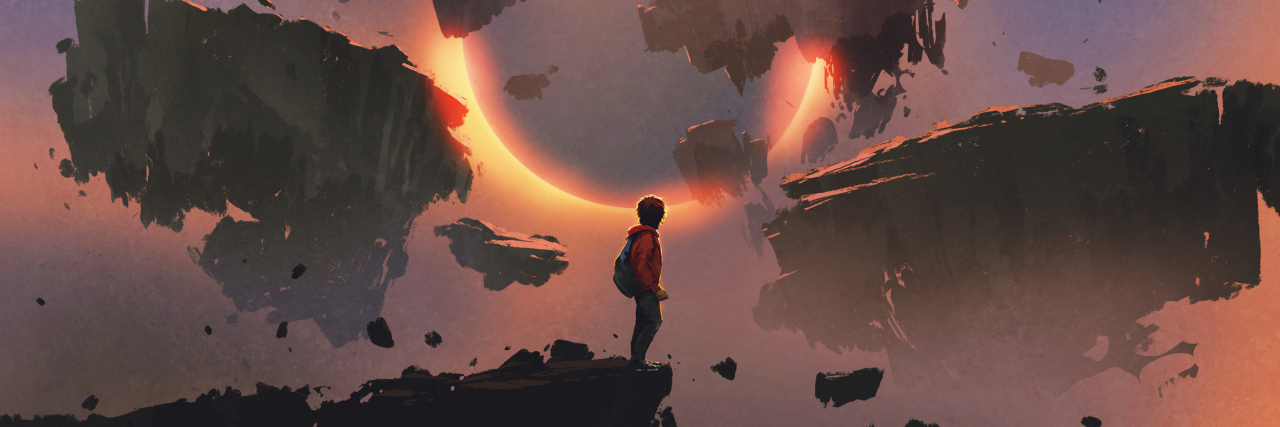Let me tell you a story. One day, a teenage boy went to his local town to do some shopping. As he was traveling down the department store escalator on his way to the exit, he accidentally dropped a 20-pence piece. He looked around, trying to locate it, but couldn’t see it anywhere. As he left the store he thought to himself, “I wonder if that might cause any trouble?”
Later that day, he turned on the news. That very same department store had caught fire. Many had died. Early investigations, whilst inconclusive, pointed to something getting caught in the escalator’s mechanism, causing a malfunction and the ensuing inferno.
The boy was horrified at what he had done. He was horrified that this was something he’d have to live with until his dying day.
The first part of that story – up until the boy leaves the department store – is true. Everything after that unfolded purely in my mind.
The imagination is an impressive human feature. It is our best friend; it provides the spark that leads to human creativity and achievement, as well as the prescience to anticipate and tackle problems ahead. It can also be our worst enemy; it can spin out of control and consume us with nothing but impending doom.
Here’s a tip: never ask someone with anxiety, “what’s the worst that could happen?” Our ability to tell disaster stories can be sort of impressive. They start off ordinarily enough. One pleasant spring morning, a boy goes to his local town to do some shopping. Then the trigger: He drops a 20-pence piece on the escalator. Rapidly, as the disasters unfold, the chapters of our story become shorter and more frantic. The coin gets lodged, causes a fire, and people die. Each chapter zips by, faster and faster, like stations glanced at in terror from a runaway train. The exponential cycle of fear reaches a crescendo. The storyteller is soon drowned out by a hysterical din of their own making.
But our imaginations aren’t done with us yet.
Up next is what masquerades as the “problem-solving” part: “Should I call the store to warn them? They’ll think I’m ‘crazy.’ Do I get the bus back into town and return to the scene of my crime, so I can press the ‘emergency stop’ on the escalator and search for the coin? Maybe if I go back into town, and get to the escalator just as the fire is starting — at least I will perish along with my victims in some kind of twisted poetic justice.”
That little rational voice in our head (for it’s there, even if it is struggling to be heard over the commotion) is shouting at the top of its lungs, “really?” but for now at least, our only true friend in this nightmare is being ignored.
And so continues our vicious circle of relentless rumination, or “catastrophizing” as it is known in the parlance of clinical anxiety.
Over millennia, the human imagination has become a vital part of our evolution. Insofar as it helps us to solve problems, our ability to worry has played a significant role in the success of our species. It means we can learn from mistakes, as well as anticipate and prepare for problems ahead. But there comes a point, very quickly, where worry ceases to be useful; where it rapidly spirals into self-perpetuating chaos.
Let me tell you another story. It’s a variation of an old tale told by Dr. Martin Rossman, in a lecture of his I found online.
An elderly man spends all day, every day, walking the same route around his house, carrying a bunch of twigs. He circles this never-ending journey day after day, month after month; for so long in fact that he cuts a furrow along his route that comes up as far as his knees. One day, a neighbor can’t take it anymore. She calls in and demands, “Why do you keep walking around your house, carrying a bunch of twigs like this?!”
“I’m keeping my house safe from tigers,” he says.
“But this is Yorkshire. There are no tigers here!” cries his neighbor.
“See?” he replies.
Research suggests that the vast majority of worries people with anxiety have about the future never actually come true. In his lecture, Rossman suggests that as far as the person’s brain is concerned, the reason why these things don’t happen is precisely because we worry about them. In other words, worry becomes a learned and self-perpetuating behavior — a habit that is tough to break.
So, how do we break that habit? Well, if there was an easy answer to that then I imagine there’d be a lot less anxiety around. For me, after 20 years of non-medicated solutions — including cognitive behavioral therapy (CBT), through which I discovered “The Worry Tree” (which is now available as an app, recommended by the NHS) — I ended up opting for medication. It’s no silver bullet, but it helps a lot.
A vivid imagination can be a powerful ally. I wonder whether my tendency to focus on “what could go wrong” has made me a more thoughtful and considerate person? I have no doubt that it has contributed toward a creative life and stimulating career. But, on the other hand, an imagination that knows no limits risks fearing nothing but the worst, and can lead to a seemingly endless worry-churn that we struggle to switch off.
The question, of course, is how do we strike a happy balance?
You can follow me on Twitter @wsadlertweets
If you are experiencing a mental health crisis, in the UK, Samaritans can be contacted on 116 123. In the US, the National Suicide Prevention Lifeline is 1-800-273-8255. In Australia, the crisis support service Lifeline is on 13 11 14. Other international crisis helplines can be found at www.befrienders.org.
Getty Images illustration via Grandfailure

